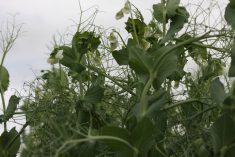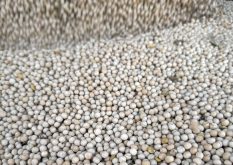Canada exports to only two major destinations — the U.S. and Egypt — and shipments to both markets have plummeted
SASKATOON — Canada’s fababean acres were well off their peak this year.
Growers planted 81,100 acres of the pulse crop, falling well short of the 121,000 acres sown in 2021, according to Statistics Canada.
Related stories:
“One major change that has taken place is that Alberta has overtaken Saskatchewan as the province with the highest acreage,” Marlene Boersch, managing partner of Mercantile Consulting Venture, said in an article she recently wrote for Saskatchewan Pulse Growers.
Read Also

Fertilizer method’s link to emissions studied
A researcher says others studying greenhouse gas emissions aren’t considering how the loss of nitrogen into the atmosphere correlates with fertilizer application or if there is an impact to yield.
“This makes sense to us, as marketing of the crop is the biggest problem, and the main feed markets are located in Alberta.”
Alberta farmers seeded 48,600 acres of the pulse. Saskatchewan growers planted 26,400 acres. Manitoba accounted for the small remainder.
Statistics Canada does not have a production estimate, but Mercantile pegged the crop at 97,500 tonnes, down nine per cent from last year.
“Canadian export performance over the past six years shows that fababean use is increasingly a domestic affair, with only two major destinations: Egypt and the United States.”
Canada exported 7,681 tonnes of the crop to the U.S. in 2023 and 324 tonnes to Egypt.
Sales through the first seven months of 2024 include 7,049 tonnes shipped to the U.S. and 1,153 tonnes to Egypt.
Total exports plummeted to 8,529 tonnes in 2023 from 38,942 tonnes shipped in 2019.
The main global exporters of the crop are Australia, the United Kingdom and France.
Boersch said export demand for Canadian fababeans has been quiet due to sufficient production in Australia.
Mostyn Gregg, vice-president of grains and pulses with Olam, recently said during a Global Pulse Confederation webinar that he is anticipating 550,000 to 650,000 tonnes of Australian production, which would be about the same as last year.
Phenomenal crops in northern New South Wales should offset frost and drought-damaged crops in Victoria and South Australia.
“I’ve seen some bean crops there where you look like you’re in the Garden of Eden,” he said.
“I’m 5′ 9″ and I think I could hide behind a few of them.”
Mitchell Elks, a trader with AGT Foods, said the crops in South Australia are less than one metre high, which is shorter than normal.
However, they managed to avoid the frost damage that Australia’s lentil crop suffered.
“It’s not a write-off at all compared to lentils,” he said.
Farmers planted lentils in marginal growing areas following four years of fabulous prices, and it did not pay off for many of them.
Elks said there are good pockets of fababean production in western Victoria and fabulous crops in New South Wales.
He is forecasting 600,000 tonnes of production, but it could go as high as 650,000 tonnes.
The problem is going to be getting the crop to market because there are no bulk terminals in northern New South Wales that accept fababeans.
That means 200,000 to 250,000 tonnes of the crop will have to be trucked to Brisbane in Queensland or to the border of Victoria or South Australia at a high cost.
“It’s just a bit messy,” he said.
Boersch said Egypt is by far the world’s leading importer of fababeans, taking 500,000 to 550,000 tonnes annually. It imports primarily from the U.K., Australia and France.
“The quality requirements in Egypt are stringent, and medium to large seed size fababeans with high tannin are preferred for food use as well as for processing into concentrated protein fractions,” she said in her SaskPulse article.
“It is hard for Canadian product to compete with U.K., Australian and French fababeans on quality as well as on freight costs.”
Instead, Canada’s fababeans are being used in the domestic pet food and livestock feed markets.
Crop prices are set by the feed market, where they are currently being sold for around $8 per bushel.
“Fababeans are also increasingly used for fractioning, but volumes are still small, and this market has been growing more slowly than anticipated,” said Boersch.
Contact sean.pratt@producer.com


















